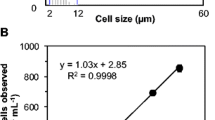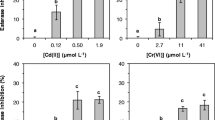Abstract
Membrane integrity has been used as a criterion for the definition of cell viability. In the present work, staining conditions (time and dye concentration) for the evaluation of membrane integrity in a fluorescence microplate reader, using the membrane-impermeant nucleic-acid dye SYTOX Green, were optimized. Incubating Pseudokirchneriella subcapitata algal cells with 0.5 μmol/l SYTOX Green for 40 min allowed a clear discrimination between live (intact plasma membrane) and dead cells (with compromised plasma membrane). Algal cell suspensions, labelled with SYTOX Green, exhibited a green fluorescence proportional to the fraction of the cells with a permeabilized plasma membrane. The optimized staining conditions were used to assess the toxicity of 1-pentanol on P. subcapitata in a short-term exposure (6 h) assay. The loss of membrane integrity in the cell population increased with the concentration of 1-pentanol. The 6-h EC10 and EC50 values were 7,617 mg/l 1-pentanol (95 % confidence limits 4,670–9,327) and 12,818 mg/l 1-pentanol (95 % confidence limits 10,929–15,183), respectively. The developed microplate-based short-term assay can be useful in the high-throughput screening of toxics or environmental samples using the alga P. subcapitata.





Similar content being viewed by others
References
Arsenault G, Cvetkovic AD, Popovic R (1993) Toxic effects of copper on Selenastrum capricornutum measured by a flow cytometer-based method. Water Poll Res J Can 28:757–765
Binet MT, Stauber JL (2006) Rapid flow cytometric method for the assessment of toxic dinoflagellate cyst viability. Mar Environ Res 62:247–260
Blaise C, Menard L (1998) A micro-algal solid-phase test to assess the toxic potential of freshwater sediments. Water Qual Res J Can 33:133–151
Blaise C, Vasseur P (2005) Algal microplate toxicity test. In: Blaise C, Férard J-F (eds) Small-scale freshwater toxicity investigations, vol 1. Springer, Dordrecht, pp 137–179
Chang DW, Hsieh ML, Chen YM, Lin TF, Chang JS (2011) Kinetics of cell lysis for Microcystis aeruginosa and Nitzschia palea in the exposure to β-cyclocitral. J Hazard Mater 185:1214–1220
Daly RI, Ho L, Brookes JD (2007) Effect of chlorination on Microcystis aeruginosa cell integrity and subsequent microcystin release and degradation. Environ Sci Technol 41:4447–4453
Franklin DJ, Berges JA (2004) Mortality in cultures of the dinoflagellate Amphidinium carterae during culture senescence and darkness. Proc R Soc Lond Ser B Biol Sci 271:2099–2107
Franklin NM, Adams MS, Stauber JL, Lim RP (2001) Development of an improved rapid enzyme inhibition bioassay with marine and freshwater microalgae using flow cytometry. Arch Environ Contam Toxicol 40:469–480
Franklin NM, Stauber JL, Adams MS (2005) Improved methods of conducting microalgal bioassays using flow cytometry. In: Ostrander GK (ed) Techniques in aquatic toxicology, vol 2. CRC, Boca Raton, pp 735–756
Fritzsche M, Mandenius CF (2010) Fluorescent cell-based sensing approaches for toxicity testing. Anal Bioanal Chem 398:181–191
Haugland RP (2005) Assays for cell viability, proliferation and function. In: Spence MTZ (ed) The handbook—a guide to fluorescent probes and labeling technologies, 10th edn. Invitrogen Corp, Eugene, pp 699–776
Lin TF, Chang DW, Lien SK, Tseng YS, Chiu YT, Wang YS (2009) Effect of chlorination on the cell integrity of two noxious cyanobacteria and their releases of odorants. J Water Supply Res Technol AQUA 58:539–551
Nagai T, Ishihara S, Yokoyama A, Iwafune T (2011) Effects of four rice paddy herbicides on algal cell viability and the relationship with population recovery. Environ Toxicol Chem 30:1898–1905
OECD (1984) Alga, growth inhibition test (201) OECD guideline for testing of chemicals. Organization for Economic Co-Operation and Development, Paris 1-14
Peperzak L, Brussaard CPD (2011) Flow cytometric applicability of fluorescent vitality probes on phytoplankton. J Phycol 47:692–702
Regel RH, Brookes JD, Ganf GG, Griffiths R (2004) The influence of experimentally generated turbulence on the Mash01 unicellular Microcystis aeruginosa strain. Hydrobiologia 517:107–120
Ribalet F, Berges JA, Ianora A, Casotti R (2007) Growth inhibition of cultured marine phytoplankton by toxic algal-derived polyunsaturated aldehydes. Aquat Toxicol 85:219–227
Rogers NJ, Franklin NM, Apte SC, Batley GE, Angel BM, Lead JR, Baalousha M (2010) Physico-chemical behaviour and algal toxicity of nanoparticulate CeO2 in freshwater. Environ Chem 7:50–60
Sato M, Murata Y, Mizusawa M, Iwahashi H, Oka S (2004) A simple and rapid dual-fluorescence viability assay for microalgae. Microbiol Cult Collect 20:53–59
Segovia M, Berges JA (2009) Inhibition of caspase-like activities prevents the appearance of reactive oxygen species and dark-induced apoptosis in the unicellular chlorophyte Dunaliella tertiolecta. J Phycol 45:1116–1126
Snell TW, Mitchell JL, Burbank SE (1996) Rapid toxicity assessment with microalga using in vivo esterase inhibition. In: Ostrander GK (ed) Techniques in aquatic toxicology testing. CRC, Boca Raton, pp 13–22
Timmermans KR, Veldhuis MJW, Brussaard CPD (2007) Cell death in three marine diatom species in response to different irradiance levels, silicate, or iron concentrations. Aquat Microb Ecol 46:253–261
U.S.-EPA (2002) Short-term methods for estimating the chronic toxicity of effluents and receiving waters to freshwater organisms, 4th edn. EPA-821-R-02-013, Environmental Protection Agency, Washington, DC, pp 1–350
Veldhuis MJW, Kraay GW, Timmermans KR (2001) Cell death in phytoplankton: correlation between changes in membrane permeability, photosynthetic activity, pigmentation and growth. Eur J Phycol 36:167–177
Vives-Rego J, Lebaron P, Nebe-von Caron G (2000) Current and future applications of flow cytometry in aquatic microbiology. FEMS Microbiol Rev 24:429–448
Acknowledgments
The authors thank the Fundação para a Ciência e a Tecnologia (FCT) through the Portuguese Government for their financial support of this work through the grant PEST-OE/EQB/LA0023/2011 to IBB. Manuela D. Machado gratefully acknowledges the post-doctoral grant from FCT (SFRH/BPD/72816/2010).
Author information
Authors and Affiliations
Corresponding author
Electronic supplementary material
Below is the link to the electronic supplementary material.
ESM 1
(PDF 7003 kb)
Rights and permissions
About this article
Cite this article
Machado, M.D., Soares, E.V. Development of a short-term assay based on the evaluation of the plasma membrane integrity of the alga Pseudokirchneriella subcapitata . Appl Microbiol Biotechnol 95, 1035–1042 (2012). https://doi.org/10.1007/s00253-012-4185-y
Received:
Revised:
Accepted:
Published:
Issue Date:
DOI: https://doi.org/10.1007/s00253-012-4185-y




